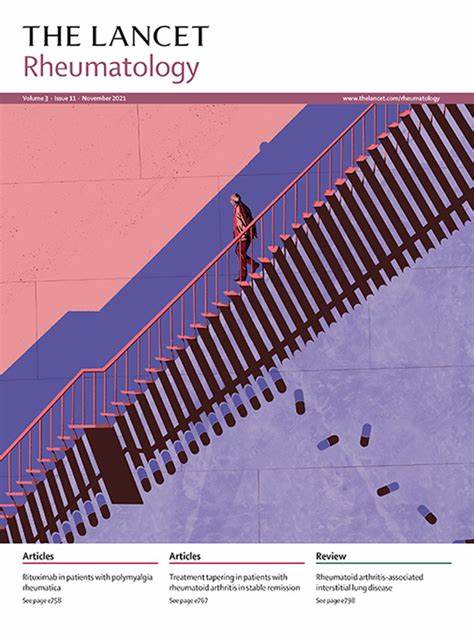TNF抑制剂治疗银屑病关节炎和轴性脊柱性关节炎在荷兰的疗效:DRESS-PS试验24个月随访
IF 16.4
1区 医学
Q1 RHEUMATOLOGY
引用次数: 0
摘要
背景:DRESS-PS试验的结果显示,在银屑病关节炎和轴性脊柱性关节炎患者中,逐渐减少TNF抑制剂的治疗策略不逊于继续使用相同剂量的TNF抑制剂长达12个月。本研究旨在描述参加DRESS-PS试验的患者在长达24个月的时间内TNF抑制剂逐渐减少的有效性。方法:本研究是在荷兰Sint Maartenskliniek, Nijmegen和Woerden进行的最初的12个月,开放标签,非劣效性DRESS-PS试验的12个月的观察性扩展。年龄在16岁及以上的银屑病关节炎或轴性脊柱炎患者,至少6个月稳定的低疾病活动度参与了最初的DRESS-PS试验。患者被随机分配到治疗到目标的逐渐减少策略(干预组),其中包括延长TNF抑制剂剂量之间的间隔,导致剂量为定义日剂量的100%,66%,50%或0%,或治疗到目标的策略没有逐渐减少(对照组)。所有参加DRESS-PS试验的患者都有资格参加这项扩展研究,在该研究中,所有患者都允许治疗到目标的逐渐减少,并且治疗决策是通过医生和患者之间的共同决策来做出的。主要结局是原始干预组和对照组在24个月时疾病活动度低的患者比例的差异;将该差异(随机化分层因素调整后)与原始DRESS-PS试验中预先指定的20%的非劣效性裕度进行比较,并从调整后的95% ci中确定非劣效性。在这项扩展研究的设计、招募、实施、分析或报告中,没有涉及有银屑病关节炎或轴性脊柱炎生活经验的人。DRESS-PS试验已在荷兰试验登记册(NL6771)注册。结果:在2020年1月8日至2022年10月10日期间,来自DRESS-PS试验的122名患者中有114名参加了这项扩展研究:79名来自原始干预组(40名患有银屑病关节炎,39名患有轴性脊柱炎),35名来自原始对照组(18名患有银屑病关节炎,17名患有轴性脊柱炎)。平均年龄50.0岁(SD 14.5)。男性70例(61%),女性44例(39%)。干预组24个月时疾病活动度低的患者比例为67%(67例患者中有45例),对照组为72%(32例患者中有23例),调整后差异为5% (95% CI -15 ~ 24;P =0·64),超过了预定的非劣效裕度。通过缺失数据的输入,调整后的差异为2%(-18至16;P =0·85),在非劣效性范围内。干预组79例患者中有78例(99%),对照组35例患者中有31例(89%)在整个24个月的研究期间至少发生一次不良事件(差异10%[-1至21];p = 0·060)。两组之间在特别关注的不良事件:感染和注射部位反应方面没有显著差异。结论:对银屑病关节炎和轴性脊柱性关节炎患者来说,从治疗到靶向的TNF抑制剂减量治疗对于维持低活动性长达2年仍然是有效和安全的。未来的研究应该探索在这些患者的常规护理中实施逐渐减少策略的挑战。资金:ReumaNederland。本文章由计算机程序翻译,如有差异,请以英文原文为准。
Effectiveness of treat-to-target tapering of TNF inhibitors for psoriatic arthritis and axial spondyloarthritis in the Netherlands: 24-month follow-up of the DRESS-PS trial
Background
Results of the DRESS-PS trial showed that a tapering strategy with TNF inhibitors is non-inferior to continuation of the same TNF inhibitor dose for up to 12 months in patients with psoriatic arthritis and axial spondyloarthritis. This study aimed to describe the effectiveness of TNF inhibitor tapering for up to 24 months in patients who participated in the DRESS-PS trial.
Methods
This study was a 12-month observational extension of the original 12-month, open-label, non-inferiority DRESS-PS trial conducted at the Sint Maartenskliniek, Nijmegen and Woerden, the Netherlands. Patients aged 16 years and older with psoriatic arthritis or axial spondyloarthritis and stable low disease activity for at least 6 months participated in the original DRESS-PS trial. Patients were randomly assigned to either a treat-to-target tapering strategy (the intervention group), which involved extending the interval between TNF inhibitor doses, resulting in doses of 100%, 66%, 50%, or 0% of the defined daily dose, or to a treat-to-target strategy without tapering (the control group). All patients who participated in the DRESS-PS trial were eligible to participate in this extension study, in which treat-to-target tapering was allowed for all patients, and treatment decisions were made through shared decision making between physicians and patients. The primary outcome was the difference between the original intervention and control groups in the proportion of patients with low disease activity at 24 months; this difference (adjusted for stratification factors at randomisation) was compared, without and with imputation, with the prespecified non-inferiority margin of 20% from the original DRESS-PS trial, and non-inferiority was determined from the adjusted 95% CIs. There was no involvement of people with lived experience of psoriatic arthritis or axial spondyloarthritis in the design, recruitment, conduct, analysis, or reporting of this extension study. The DRESS-PS trial was registered with the Dutch Trial Register, NL6771.
Findings
Between Jan 8, 2020, and Oct 10, 2022, 114 of the 122 patients from the DRESS-PS trial participated in this extension study: 79 from the original intervention group (40 with psoriatic arthritis, 39 with axial spondyloarthritis) and 35 from the original control group (18 with psoriatic arthritis, 17 with axial spondyloarthritis). Mean age was 50·0 years (SD 14·5). 70 (61%) patients were men and 44 (39%) were women. The proportion of patients with low disease activity at 24 months was 67% (45 of 67 patients) in the intervention group and 72% (23 of 32 patients) in the control group, with an adjusted difference of 5% (95% CI –15 to 24; p=0·64), which exceeded the prespecified non-inferiority margin. With imputation of missing data, the adjusted difference was 2% (–18 to 16; p=0·85), which fell within the non-inferiority margin. 78 (99%) of 79 patients in the intervention group and 31 (89%) of 35 patients in the control group had at least one adverse event over the full 24-month study period (difference 10% [–1 to 21]; p=0·060). There were no significant differences between groups in adverse events of special interest: infections and injection site reactions.
Interpretation
Treat-to-target tapering of TNF inhibitors remains effective and safe for the maintenance of low disease activity for up to 2 years in patients with psoriatic arthritis and axial spondyloarthritis. Future research should explore the challenges to implementation of tapering strategies in routine care in these patients.
Funding
ReumaNederland.
求助全文
通过发布文献求助,成功后即可免费获取论文全文。
去求助
来源期刊

Lancet Rheumatology
RHEUMATOLOGY-
CiteScore
34.70
自引率
3.10%
发文量
279
期刊介绍:
The Lancet Rheumatology, an independent journal, is dedicated to publishing content relevant to rheumatology specialists worldwide. It focuses on studies that advance clinical practice, challenge existing norms, and advocate for changes in health policy. The journal covers clinical research, particularly clinical trials, expert reviews, and thought-provoking commentary on the diagnosis, classification, management, and prevention of rheumatic diseases, including arthritis, musculoskeletal disorders, connective tissue diseases, and immune system disorders. Additionally, it publishes high-quality translational studies supported by robust clinical data, prioritizing those that identify potential new therapeutic targets, advance precision medicine efforts, or directly contribute to future clinical trials.
With its strong clinical orientation, The Lancet Rheumatology serves as an independent voice for the rheumatology community, advocating strongly for the enhancement of patients' lives affected by rheumatic diseases worldwide.
 求助内容:
求助内容: 应助结果提醒方式:
应助结果提醒方式:


